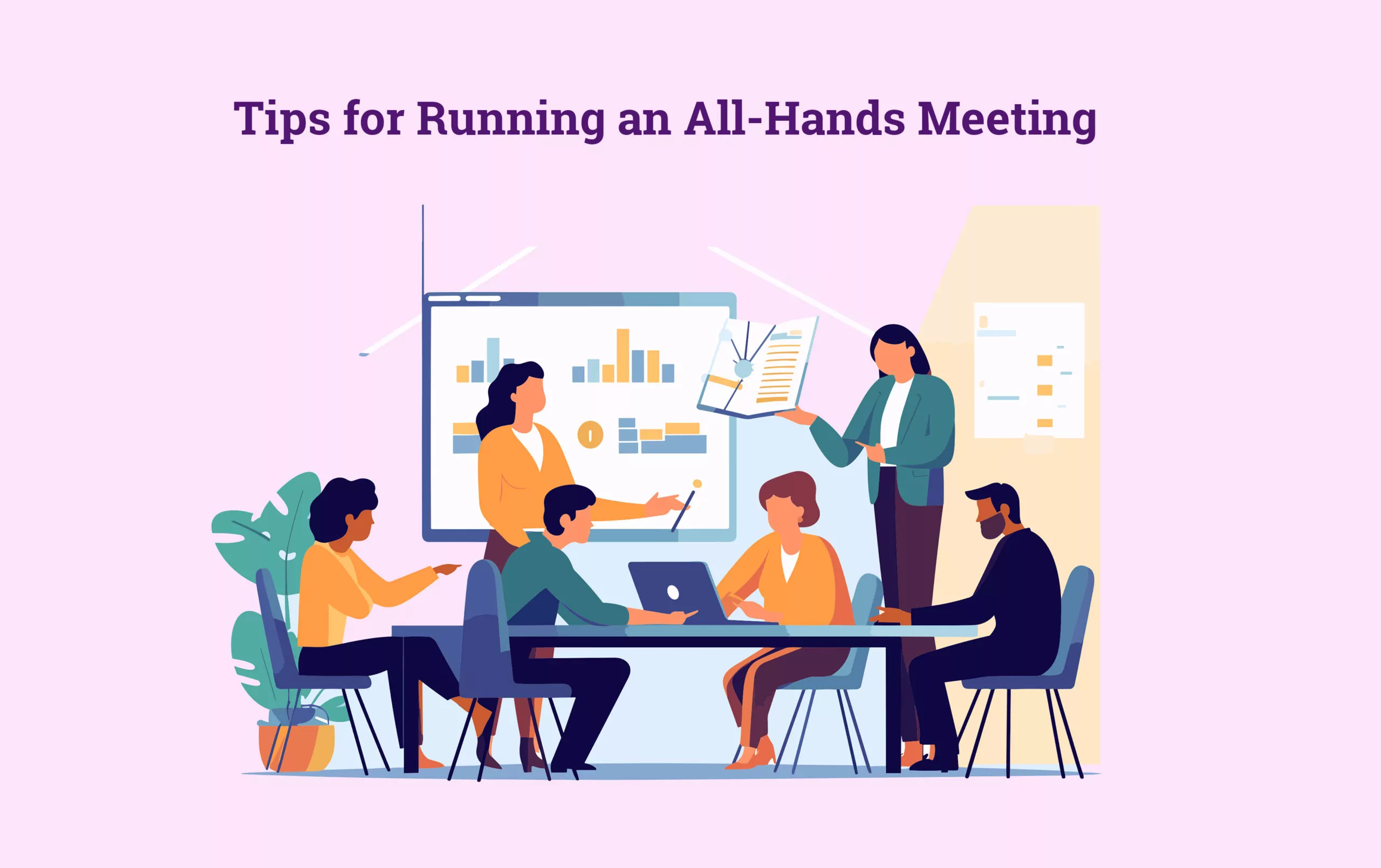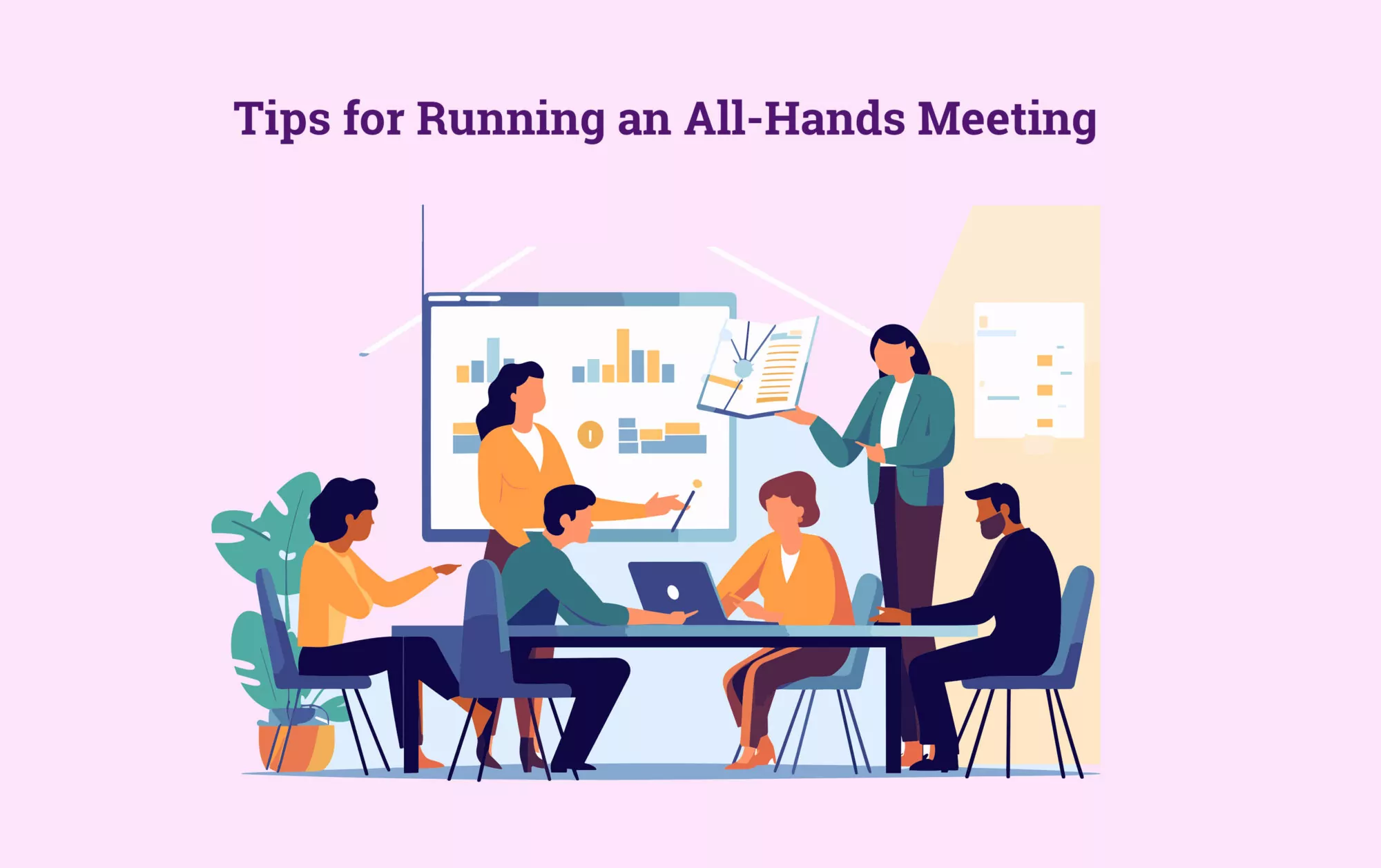Tips for Running an All-Hands Meeting

When was the last time you conducted an all-hands meeting? These types of meetings can help to ensure transparency throughout the company, they can get people together to more easily disseminate information and ask questions, and it’s easier to discuss organizational goals. These types of meetings can also be helpful when discussing company culture and important news that will affect everyone. When the all-hands meeting goes according to plan, those who attend are generally more engaged, motivated, and inspired.
Of course, there is the chance that the all-hands meeting might not go quite as well As you hope. If that’s the case, it might have a neutral effect where nobody feels affected either positively or negatively. It could be worse, though. When the meeting doesn’t go accordingly, there’s a chance that some of the attendees might feel less engaged or even frustrated.
All-hands meetings need to be done correctly. Later, we will be talking about the best practices for running these sorts of meetings.
The Importance of an All-Hands Meeting

Your company likely has quite a few smaller meetings that take place regularly, such as standard department or team meetings. While those can be important, all-hands meetings should not be overlooked. Below are a couple of the benefits of these types of meetings.
Everyone feels like they are on the same page… because they are. When everyone is involved at these all-hands meetings, it reduces the feelings of being “separate” that many companies have. These meetings help to drive alignment between those in different departments and at different levels in the company. It ensures everyone knows important information about the company as a whole, and about any pertinent news happening in various departments.
The meeting can also help to give teams a big-picture view of how what they are doing affects the company as a whole. These meetings help to drive more transparency and they ensure that people understand how what they do contributes to the business in general. They get to have a better sense of the company’s goals both short and long-term.
With added transparency comes trust. Having all-hands meetings can help to bring the members of the company close together. They feel that they know more about the company and where its interests lie. The employees have a truer sense of the role they play.
Now that you have a better idea of just why these types of meetings are important, you will need to know how to make them effective.
All-Hands Meetings: Best Practices
These meetings can produce some nice benefits for your company and your employees. Of course, this is all dependent on you holding these meetings the right way. To help make matters easier, consider the following best practices.
Announce the Meeting Carefully
If this is going to be the first all-hands meeting you are holding, it’s important that you don’t inadvertently frighten your employees. When they see that there’s an upcoming all-hands meeting and they don’t have any context for it, they might get a little worried. They could think they are losing their jobs because people often take a flying leap to the worst-case scenario.
Therefore, when you say that you need to have a meeting with all of the staff, it’s a good idea to include an agenda. Let people know what you will be talking about in the meeting, so they have an idea of what is coming. Not doing this is just going to make people worry and gossip.
Keep the Meeting Tight and on Time
If you want your meeting to have an effective result, you need to make sure people stay engaged. One of the best ways to do this is by not overstaying your welcome. No one likes to be in meetings for any longer than necessary. Therefore, you will want to make it a point to keep the meetings as brief as possible. The longer they are the easier it is to lose peoples’ attention.
Most of the time, you will want to make sure the meetings are between half an hour to an hour at most. Additionally, you need to make sure that you start and end the meeting on time. After all, meetings that don’t start and end on time eat into an already busy day. The employees are already taking time away from the usual tasks to go to the meeting, so it’s natural that people get upset when things don’t start and end on time.
The Content
The content discussed in the meeting will vary, of course. However, you want to make sure that the meeting stays relevant to as many people in the company as possible. Therefore, the content discussed in the meeting should be relevant companywide. Instead of having a meeting take a deep dive into what just one department is doing, it’s better to have it broadly focused as an overview of what’s happening in the company at different levels. Don’t get too involved in just one area, as it could lose the focus of a lot of the people in attendance.
Share Opportunities Not Just News
One of the things a lot of companies do is focus on the big-picture business stuff and the positives during these meetings. There’s nothing wrong with that, but it’s important to realize that the meetings could contain some other types of content, too. For example, it’s nice to also share company opportunities. If there are management positions opening, for example, let people know in the meeting and tell them what they need to do to be considered. Think about the sorts of things that your employees might like to know that are happening within the company.
Consider a Q and A
While this might not be something needed for all companies, question and answer sessions at some all-hands meetings could be a good idea. This is especially true in those cases where some big changes are happening.
You might open the floor to questions from your employees, but in a lot of companies, you don’t want to necessarily have a microphone on the floor to allow hundreds of people to ask questions. Instead, consider asking the team to submit questions they might have regarding some of the topics covered. Then you can answer those questions at the meeting. It will keep things moving more quickly.
Ask for Meeting Feedback
Something else you should do is ask your employees who attended for some feedback about the meeting. Have them fill out a form that you email to them asking about what they thought about the meeting, what could be improved, what they might like to see changed in the next meeting, etc. Getting and listening to the feedback could help your organization to improve the effectiveness of the all-hands meetings.
How Often Should an All-Hands Meeting Be Scheduled?
Should you hold an all-hands meeting annually? Twice a year? Quarterly? The answer to this question will vary, as it will depend on several factors specific to each company.
One of the first things you will have to consider is the size of your organization. If you have a relatively small company, it would be easy to get everyone together for one of these meetings regularly. However, because of the small nature of the company, there’s a good chance that there is already a lot of transparency and easier communication. These companies might not need to have more than one meeting a year that’s all-hands.
When you have a larger company, it will be more of a challenge to get everyone together in person. Fortunately, various tools can help make it a little easier. For example, online meeting tools can be used to connect people who might be in different parts of the country or world.
The communication standards you have at your company can also play a role. If you have teams of open communicators, you probably won’t need to have as many staff meetings. However, if you have communication that happens less regularly, then getting everyone in the company together more regularly is a good idea.
Of course, before calling a meeting, you will also need to make sure that it’s worthy of a full staff meeting. Big news about major changes to the company, start or end-of-year news, etc. might be a reason to call one of these meetings. It will all depend on what is considered important enough for your organization to hold a meeting.
Plan Your Meeting Now
If you have an all-hands meeting to hold, it’s a good idea to get started as soon as possible. Whether it’s online only, in-person, or a mixture, those who will be hosting the all-hands meeting should start planning early. Whether there are only a dozen or so employees or thousands, it’s important to plan early for the meeting. Make sure any technology that will be used is operating properly before the meeting starts. Follow the other tips and guidance discussed above, as well, and start planning.